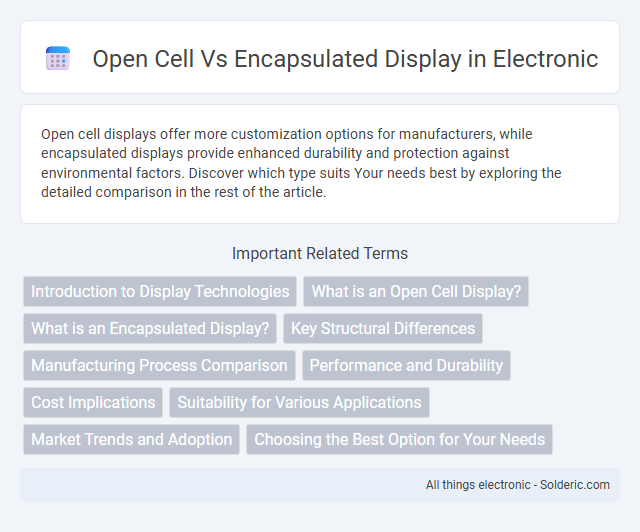Open cell displays offer more customization options for manufacturers, while encapsulated displays provide enhanced durability and protection against environmental factors. Discover which type suits Your needs best by exploring the detailed comparison in the rest of the article.
Comparison Table
| Feature | Open Cell Display | Encapsulated Display |
|---|---|---|
| Definition | LCD panel without protective layers or cover glass | LCD panel sealed with cover glass and protective layers |
| Durability | Less durable, prone to damage and dust | Highly durable, resistant to impact and contamination |
| Integration | Requires additional lamination and touch panel integration | Ready for direct integration with touch and cover glass |
| Cost | Lower initial cost | Higher cost due to encapsulation process |
| Visual Quality | Potential for air gaps affecting clarity | Improved optical clarity, reduced reflections |
| Usage | Ideal for customized displays in controlled environments | Preferred for rugged, commercial, and consumer devices |
Introduction to Display Technologies
Open cell and encapsulated displays represent two foundational technologies in modern screen manufacturing, impacting durability, image clarity, and cost. Open cell displays consist of just the LCD panel without protective layers, allowing manufacturers or brands to add custom encapsulation for enhanced protection or specific functionalities. Your choice between open cell and fully encapsulated displays affects device performance, environmental resistance, and repairability, making understanding these differences crucial for selecting the right display technology.
What is an Open Cell Display?
An Open Cell Display refers to a raw LCD panel without a backlight or other components, sold directly to manufacturers for integration into final devices. This type of display provides greater customization options for your product's backlight, touch sensor, and protective layers, allowing for tailored performance and cost efficiency. Typically used in smartphones, tablets, and monitors, open cell displays offer flexibility in design but require additional assembly compared to encapsulated displays.
What is an Encapsulated Display?
An encapsulated display features a protective layer that seals the OLED or LCD panel, enhancing durability and resistance to moisture and dust compared to open cell designs. This encapsulation process improves the longevity and reliability of the display, making it suitable for high-end smartphones, wearables, and outdoor devices. The added layer also boosts display brightness and color accuracy by reducing external interference and light diffusion.
Key Structural Differences
Open cell displays feature a bare LCD panel without a backlight or protective layers, allowing manufacturers to customize backlighting and touch solutions independently. Encapsulated displays integrate the LCD panel with backlighting, polarizers, and touch sensors as a single module, providing enhanced durability and simplified assembly. The encapsulation process improves protection against moisture and physical damage, distinguishing it from the more flexible but exposed open cell structure.
Manufacturing Process Comparison
Open cell displays undergo a manufacturing process where the display module is produced without a backlight or cover glass, allowing OEMs to customize these components later, reducing costs and enabling design flexibility. Encapsulated displays integrate the LCD panel, backlight unit, and cover glass during the manufacturing stage, providing better protection against moisture and dust, enhancing durability and improving display quality out of the box. The encapsulation process typically involves sealing layers with adhesives and protective films, resulting in a more robust and reliable display assembly compared to the modular approach of open cell manufacturing.
Performance and Durability
Open cell displays typically offer enhanced brightness and color accuracy due to their thinner design and reduced light diffusion, but they are more vulnerable to moisture and dust, impacting long-term durability. Encapsulated displays provide superior protection against environmental factors such as humidity and physical damage, ensuring greater longevity and reliability in harsh conditions. Your choice between open cell and encapsulated displays should balance the need for high-performance visuals with the demand for durability based on your application environment.
Cost Implications
Open cell displays generally have lower manufacturing costs due to the absence of integrated protective layers, reducing material and assembly expenses. Encapsulated displays include additional sealing and lamination processes to protect the display from moisture and dust, which increases production costs but enhances durability. Choosing between open cell and encapsulated displays depends on balancing initial cost savings against long-term performance and reliability requirements.
Suitability for Various Applications
Open cell displays offer greater flexibility and cost-effectiveness, making them suitable for applications where customization and budget constraints are priorities, such as in DIY projects or prototype development. Encapsulated displays provide enhanced durability and environmental protection, ideal for outdoor advertising, industrial equipment, or any use requiring high resistance to moisture and dust. Your choice depends on whether you prioritize adaptability in design or robust protection for demanding environments.
Market Trends and Adoption
Open cell displays dominate the market due to lower manufacturing costs and flexibility in customization, driving widespread adoption in budget and mid-range devices. Encapsulated displays gain traction in premium segments for their enhanced durability, moisture resistance, and improved color accuracy, appealing to high-end smartphones and wearables. Market trends indicate a growing shift towards encapsulated displays as consumer demand for longevity and device performance intensifies.
Choosing the Best Option for Your Needs
Selecting between open cell and encapsulated displays depends on environmental durability and application requirements. Open cell displays provide flexible integration and lower costs, ideal for controlled indoor settings, while encapsulated displays offer enhanced protection against moisture, dust, and impact, making them suitable for outdoor or harsh environments. Evaluating factors such as usage location, exposure risks, and budget constraints helps determine the optimal display choice for performance and longevity.
Open cell vs Encapsulated display Infographic

 solderic.com
solderic.com